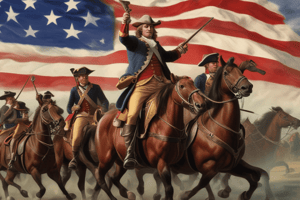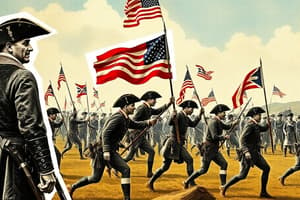Podcast
Questions and Answers
What was a significant factor in the difference between the armies of General Howe and General Washington?
What was a significant factor in the difference between the armies of General Howe and General Washington?
- Howe sought to engage in winter warfare, but Washington fought seasonally.
- Howe's army was well disciplined and experienced, while Washington's army was poorly supplied and lacked discipline. (correct)
- Howe's army consisted of inexperienced soldiers compared to Washington's disciplined troops.
- Howe's army was poorly supplied while Washington's was well provisioned.
What was the primary strategy implemented by Howe at the outset of the conflict?
What was the primary strategy implemented by Howe at the outset of the conflict?
- To scare the Americans into submission without direct confrontation. (correct)
- To bombard American positions continuously until they surrendered.
- To isolate Washington's army by cutting off supply routes.
- To engage the Continental Army directly in large battles.
What was the morale impact on the Continental Army after the threat to Philadelphia?
What was the morale impact on the Continental Army after the threat to Philadelphia?
- It led to increased recruitment of soldiers.
- It had no noticeable effect on troop morale.
- It caused morale to drop, resulting in desertions. (correct)
- It boosted morale due to patriotism after the Declaration of Independence.
What significant event took place on Christmas night 1776?
What significant event took place on Christmas night 1776?
How did many of Washington's troops suffer during the crossing of the Delaware River?
How did many of Washington's troops suffer during the crossing of the Delaware River?
What was one of the purposes of Thomas Paine's The Crisis?
What was one of the purposes of Thomas Paine's The Crisis?
What was the outcome of the Continental Army's actions at Trenton on December 26, 1776?
What was the outcome of the Continental Army's actions at Trenton on December 26, 1776?
What does the phrase 'summer soldier and sunshine patriot' in The Crisis refer to?
What does the phrase 'summer soldier and sunshine patriot' in The Crisis refer to?
What strategy did British General John Burgoyne propose for advancing on Albany?
What strategy did British General John Burgoyne propose for advancing on Albany?
Which battle marked a significant turning point in the war for the Americans?
Which battle marked a significant turning point in the war for the Americans?
What was a major consequence of the Continental Congress retreating to York, Pennsylvania?
What was a major consequence of the Continental Congress retreating to York, Pennsylvania?
During the winter at Valley Forge, what was one significant challenge faced by Washington's army?
During the winter at Valley Forge, what was one significant challenge faced by Washington's army?
What was General Howe's chief objective during his campaign?
What was General Howe's chief objective during his campaign?
Which European country officially supported the United States after the Battle of Saratoga?
Which European country officially supported the United States after the Battle of Saratoga?
Which factor contributed to the British defeat at the Battle of Saratoga?
Which factor contributed to the British defeat at the Battle of Saratoga?
What misconception did the British have regarding support for the Loyalist cause?
What misconception did the British have regarding support for the Loyalist cause?
What role did women play during the winter at Valley Forge?
What role did women play during the winter at Valley Forge?
What was one of the main reasons for the British military's failure during this phase of the war?
What was one of the main reasons for the British military's failure during this phase of the war?
What significant action did the Second Continental Congress take to support the American military effort?
What significant action did the Second Continental Congress take to support the American military effort?
What was the primary goal of the Olive Branch Petition sent to the king?
What was the primary goal of the Olive Branch Petition sent to the king?
What was the outcome of the Battle of Bunker Hill regarding casualties?
What was the outcome of the Battle of Bunker Hill regarding casualties?
Who led the surprise attack on Fort Ticonderoga?
Who led the surprise attack on Fort Ticonderoga?
How did Washington use the captured cannons from Fort Ticonderoga?
How did Washington use the captured cannons from Fort Ticonderoga?
What challenge did Benedict Arnold face during his march to Canada?
What challenge did Benedict Arnold face during his march to Canada?
What event marked the beginning of Britain’s increased military presence in America?
What event marked the beginning of Britain’s increased military presence in America?
What characteristic of the British strategy changed following their retreat from Boston?
What characteristic of the British strategy changed following their retreat from Boston?
What was the predominant outcome of the military action at Quebec in December 1775?
What was the predominant outcome of the military action at Quebec in December 1775?
What action did the Second Continental Congress take as they began to act like a government?
What action did the Second Continental Congress take as they began to act like a government?
What was one major consequence of the British capturing Charlestown, SC?
What was one major consequence of the British capturing Charlestown, SC?
What strategy did Greene employ to combat the larger British army?
What strategy did Greene employ to combat the larger British army?
What was notable about Benedict Arnold's actions during the war?
What was notable about Benedict Arnold's actions during the war?
What was the direct outcome of the Battle of Yorktown?
What was the direct outcome of the Battle of Yorktown?
What event followed the surrender of Cornwallis at Yorktown?
What event followed the surrender of Cornwallis at Yorktown?
What was the significance of the Treaty of Paris in 1783?
What was the significance of the Treaty of Paris in 1783?
Which military tactic did the Patriots utilize effectively during the Southern Campaign?
Which military tactic did the Patriots utilize effectively during the Southern Campaign?
Which of the following accurately describes the British logistical challenges during the war?
Which of the following accurately describes the British logistical challenges during the war?
How did Washington and Rochambeau deceive the British forces in Yorktown?
How did Washington and Rochambeau deceive the British forces in Yorktown?
What role did guerilla warfare play in the American strategy during conventional battles?
What role did guerilla warfare play in the American strategy during conventional battles?
Flashcards
Washington's Crossing of the Delaware
Washington's Crossing of the Delaware
A significant event in the American Revolutionary War where General George Washington led his troops across the Delaware River on Christmas night 1776, surprising and defeating Hessian soldiers in Trenton, New Jersey.
Contrasting Forces in the American Revolution
Contrasting Forces in the American Revolution
The British, under General William Howe, were well-equipped, experienced, and disciplined soldiers. In contrast, the Continental Army under Washington was poorly supplied, lacking discipline, and had little combat experience.
Seasonal Warfare in the American Revolution
Seasonal Warfare in the American Revolution
The tactics used in the American Revolutionary War were often influenced by the changing seasons, with fighting typically occurring during warmer months and slowing down during the harsh winters.
British Strategy in the Early War
British Strategy in the Early War
Signup and view all the flashcards
The Continental Army's Low Point
The Continental Army's Low Point
Signup and view all the flashcards
Thomas Paine and 'The Crisis'
Thomas Paine and 'The Crisis'
Signup and view all the flashcards
British Threat to Philadelphia
British Threat to Philadelphia
Signup and view all the flashcards
Continental Army's Retreat
Continental Army's Retreat
Signup and view all the flashcards
What was the Second Continental Congress?
What was the Second Continental Congress?
Signup and view all the flashcards
What was the Olive Branch Petition?
What was the Olive Branch Petition?
Signup and view all the flashcards
What was the Declaration of the Causes and Necessities of Taking Up Arms?
What was the Declaration of the Causes and Necessities of Taking Up Arms?
Signup and view all the flashcards
What was the Battle of Bunker Hill?
What was the Battle of Bunker Hill?
Signup and view all the flashcards
What was Fort Ticonderoga?
What was Fort Ticonderoga?
Signup and view all the flashcards
What was the Siege of Boston?
What was the Siege of Boston?
Signup and view all the flashcards
What was the American Invasion of Canada?
What was the American Invasion of Canada?
Signup and view all the flashcards
Why did Britain target New York City?
Why did Britain target New York City?
Signup and view all the flashcards
What was the Battle of Brooklyn?
What was the Battle of Brooklyn?
Signup and view all the flashcards
What was the Declaration of Independence?
What was the Declaration of Independence?
Signup and view all the flashcards
Mercenaries
Mercenaries
Signup and view all the flashcards
British Plan for Victory
British Plan for Victory
Signup and view all the flashcards
British Capture of Philadelphia
British Capture of Philadelphia
Signup and view all the flashcards
Lead up to Saratoga
Lead up to Saratoga
Signup and view all the flashcards
Battle of Saratoga
Battle of Saratoga
Signup and view all the flashcards
Results of the Battle of Saratoga
Results of the Battle of Saratoga
Signup and view all the flashcards
British Blunders
British Blunders
Signup and view all the flashcards
Valley Forge
Valley Forge
Signup and view all the flashcards
The French Alliance
The French Alliance
Signup and view all the flashcards
British Hopes for the War
British Hopes for the War
Signup and view all the flashcards
British Promise of Emancipation
British Promise of Emancipation
Signup and view all the flashcards
British Logistics vs Patriot Mobility
British Logistics vs Patriot Mobility
Signup and view all the flashcards
Shift in British Strategy
Shift in British Strategy
Signup and view all the flashcards
Benedict Arnold's Treachery
Benedict Arnold's Treachery
Signup and view all the flashcards
The Southern Campaign
The Southern Campaign
Signup and view all the flashcards
British Success and Patriot Guerilla Tactics
British Success and Patriot Guerilla Tactics
Signup and view all the flashcards
Greene's Strategy of Exhaustion
Greene's Strategy of Exhaustion
Signup and view all the flashcards
The Battle of Cowpens
The Battle of Cowpens
Signup and view all the flashcards
The Siege of Yorktown
The Siege of Yorktown
Signup and view all the flashcards
Significance of Yorktown
Significance of Yorktown
Signup and view all the flashcards
Study Notes
Phase 1: New England (1775-1776)
- Second Continental Congress: Met in May 1775 to decide on actions following Lexington and Concord. Created the Continental Army, with George Washington as commander. Printed paper money to fund the army.
- Petitioning the King: Congress sent the Olive Branch Petition (July 1775) requesting peaceful resolution of disputes. The Declaration of the Causes and Necessities of Taking Up Arms declared the colonists' readiness to defend their rights. The King ignored the petition.
- Bunker Hill: American forces, despite losing ground at Breed's Hill fought valiantly against British forces, inflicting heavy casualties. Considered a victory for the Americans, as the British lost close to 1,000 men compared to the American 400.
- Ticonderoga: On May 10, 1775, colonists captured Fort Ticonderoga, a strategic fort on Lake Champlain, crucial for control of the route to Canada. The captured weapons aided in the British evacuation of Boston.
- End of the Siege of Boston: Using the cannons from Fort Ticonderoga, Washington forced the British to evacuate Boston in 1775. Britain blockaded American ports and hired mercenaries to strengthen their forces.
- Invading Canada: Two American armies attempted to conquer Quebec in December 1775. This failed due to a combination of poor planning, terrible winter conditions, and resulting defeat.
Phase 2: Mid-Atlantic Region (1776-1778)
- New York City Campaign: Britain launched a large-scale invasion of New York City, engaging Washington's poorly-equipped and inexperienced army. The British, with larger, well-trained forces, forced the Continental Army to retreat.
- Retreat from NYC: Washington's army retreated through New York and New Jersey to Pennsylvania by December 1776. This marked a low point in the morale of the Continental army.
- The Crisis: Thomas Paine's writings boosted Patriot morale during challenging times. His writings urged support for the Continental Army.
- Crossing the Delaware: On Christmas night 1776, Washington led his forces across the Delaware River and successfully surprised and defeated Hessian troops at Trenton.
- Battles of Trenton & Princeton: The American victory at Trenton and subsequent victory at Princeton boosted Patriot morale and forced the British to focus more on the American forces and abandon the thought of a quick victory.
- British Plan for Victory (Failed): British efforts to advance on Albany from 3 directions failed due to communication issues, lack of cooperation between army generals, and American resistance.
- Philadelphia: British forces captured Philadelphia after defeating Washington at Brandywine Creek in September 1777.
- Lead-up to Saratoga: British General Burgoyne's campaign towards Albany was thwarted by American forces at Oriskany and Bennington.
- Battle of Saratoga (1777): Burgoyne's army was surrounded and forced to surrender near Saratoga, NY in October 1777. This victory was a significant turning point in the war.
- British Blunders: British mistakes like a disjointed strategy and miscalculations of the forces allowed for an American victory crucial in the turning of the tide of war
- Valley Forge: Washington's army suffered hardships during the winter of 1777-1778 at Valley Forge.
Phase 3: The South (1778-1782)
- British Strategy Shift: Britain shifted focus to the South, hoping for more Loyalist support.
- Southern Campaign: The British captured several Southern cities but faced strong Patriot resistance using guerrilla tactics, a style of fighting more suited to the environment which hurt the British Army.
- Greene's Strategy: General Nathanael Greene's strategy of dividing his forces to avoid direct engagements and use guerrilla tactics against the British was effective in weakening their army.
- Battle of Cowpens (1781): A key victory for the Americans in the South, weakening British forces further.
- Battle of Guilford Court House: Another key victory for the Americans, though Greene had to retreat, hurting the British Army.
- Yorktown, VA: The Continental Army, and French forces trapped the British army at Yorktown. Cornwallis surrendered to Washington in October 1781, a decisive outcome.
- Treaty of Paris (1783): Britain recognized American independence. The British ceded territory from the southern border of Canada to the northern border of Florida and all lands east of the Mississippi River. The treaty was signed on September 3, 1783.
Studying That Suits You
Use AI to generate personalized quizzes and flashcards to suit your learning preferences.




